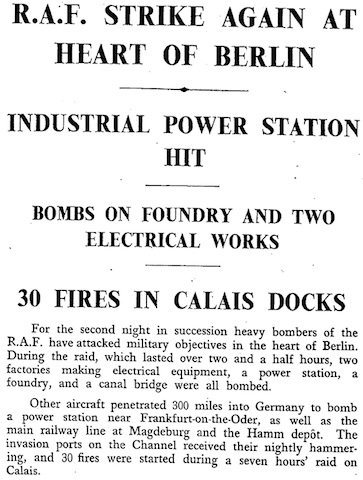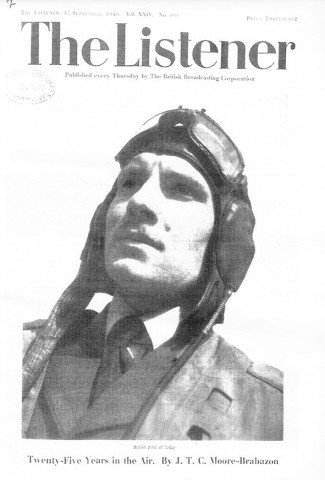
Bomber Command has been busy bombing German forests, among other targets: the Black Forest on Monday night, the Hartz [sic] in north-west Germany and the Grunewald north of Berlin on Tuesday night. According to the Air Ministry communique, issued last night and reported here in The Times (4), 'military targets [were] concealed' in these forests; 'Many fires were started which later caused explosions'. It's interesting to contrast these British attacks with a 'most determined' German one on presumably similar terrain, a big Scout camping ground, as reported on page 9, described in the headline as 'Destruction typical of the Nazi mind': 'Scout property is evidently classed as a military objective in the Nazi mind'. In each case it is assumed that bomber forces have perfect aim and perfect knowledge: each bombfall is further proof of each side's essential nature, be that good or evil.
This is part of a two-sided propaganda war. Hitler made a 'powerful and moving' speech (according to Reuter) yesterday at the Berlin Sport Palace. As he was opening the winter relief campaign, he began by scorning Britain's naval blockade:
We knew in advance that the great friend of humanity, as in the Great War, would attempt to starve women and children, and we prepared ourselves for it.
But his rhetoric reached a higher pitch when he moved on to the bomber war:
The R.A.F. bombs Germany at night not because it can do so effectively, but because it is unable to fly over the Reich by daylight. The British drop their bombs indiscriminately and without plan, on civilian residential quarters, on farms, and villages.
For three months I did not reply, because I believed they would stop, but in this Mr. Churchill saw a sign of our weakness. The British will know that we are now giving our answer night after night. We shall stop the handiwork of these night pirates. The hour will strike when one of us will break, and that will not be National-Socialist Germany.
Dr. Goebbels is also doing his part. Last night, 'many' German wireless stations (whether domestic or English-language is not clear) put out a story (3) that a Polish bomber crew flying for the RAF on a mission to Berlin landed at Warsaw instead.
The airmen said that in London they had come to realize the hopelessness of the struggle. They were prepared to give the German authorities any information in their power provided they were allowed to go free.
An assurance to this effect, the story ended, was accordingly given to them by the German authorities.
But, states The Times, Berlin was not raided on the night in question (2/3 September), only two aircraft failed to return and both had British crews, and Polish bomber squadrons in the RAF 'are not yet equipped with aircraft which could carry out a long-distance raid of this description'.
Back to Britain. Yesterday Fighter Command fended off a big German force of 200 bombers and fighters over Kent and the Thames estuary which were 'making for aerodromes and factories' (4). Particularly noteworthy was 'the rout of the new Messerschmitt Jaguar fighter-bombers', which had 'formed close protective rings against the R.A.F.'. This tactic availed them not at all: two Hurricane squadrons accounted for 12 Jaguars between them, and a Spitfire squadron shot down another 12 without even taking a hit. Here's the 'record' of 9 Hurricane pilots who bagged 6 Jaguars in total:
NUMBER 1 saw smoke belching and the final crash.
NUMBER 2 watched his enemy's cockpit burst into flames.
NUMBERS 3 and 4 silenced the rear gunners of their Jaguars.
NUMBER 5 made both engines and the fuselage of his enemy catch fire.
NUMBERS 6, 7, and 8 saw their opponents crash.
NUMBER 9 left his Jaguar with splinters flying off it.
It does sound like a 'Bad day for Jaguar fighter-bombers', as the headline put it.
![]() This work is licensed under a Creative Commons Attribution-NonCommercial-NoDerivatives 4.0 International License.
Permissions beyond the scope of this license may be available at http://airminded.org/copyright/.
This work is licensed under a Creative Commons Attribution-NonCommercial-NoDerivatives 4.0 International License.
Permissions beyond the scope of this license may be available at http://airminded.org/copyright/.





Alex
The description of "Jaguars" forming defensive circles, and that they have a rear gunner, suggests these are Messerschmitt 110s. The Germans officially classified them as Zerstörer - destroyers, like the warships. But I suppose it's possible that the paper englished Jäger - fighter or fighters - although that wouldn't be a valid translation (hunter or American-style "pursuit" being accurate).
The forest bombing, well, what can you say? Especially the Grünewald, which is inside the city limits of Berlin - at some points it's not far from the Siemensstadt.
JDK
The mythic 'Jaguar' version of the Messerschmitt Bf 110 was another aeroplane that didn't exist any more than the (then) widely reported Heinkel He 113.
The 'Me 110 Jaguar' was believed to be a variant of the Bf 110; my 1941 Hutchinson British German & Italian Aircraft book has it as a 'bomber' with a glass nose. Drawing exist in the Flight archive, and or the reprinted 1939-40 Aeroplane magazines, I vaguely recall.
Both were 'encountered' by RAF pilots; opinion varies whether the 113s were actually Hurricanes in friendly fire incidents or 109s. There's not much doubt that the 'Jaguars' they attacked were standard Bf 110s.
I'm not sure (haven't researched it) whether the were created by poor British intelligence or active German propaganda - the latter being the origin of the He 113.
Despite the multiple kills of He 113s claimed in 1940, I've yet to find a postwar pilot's biography that has any in. I wonder why?...
JDK
A little further checking shows our 'Jaguars' are as real as our He 113s.
Details of the 'Jaguar' here:
http://en.wikipedia.org/wiki/Messerschmitt_Bf_162
He 113 here:
http://en.wikipedia.org/wiki/Heinkel_He_113
Pingback:
Airminded · Friday, 6 September 1940
Pingback:
Airminded · Saturday, 7 September 1940
Brett Holman
Post authorLike Alex my first thought was some corruption of jäger; I'd never heard of the Me 162 Jaguar. I see it's in my Saville-Sneath as an Me 110 bomber variant 'chiefly distinguishable by the glazed bomb-aiming nose', and there's a photo courtesy of The Aeroplane). Here's a short article and artist's impression from Flight for 15 August 1940. It's appeared once before in this series of posts, too. It certainly got around considering only three prototypes were ever made!
Nick Lawson
Can you help make a small donation to help fund the Battle of Britain services in Canberra? Your donation will go towards refreshments , for these unofficial events. Ever penny will help!
70th Anniversary Battle of Britain Commemoration, Canberra, ACT
All donations gratefully received:
Cheques payable to: the RAAF Association, (ACT Division)
PO Box 331, Mawson, ACT 2607
Please indicate in covering letter or reverse of cheque:
‘For Battle of Britain Commemoration’.
_______________________________________________________________________________
Battle of Britain Service at the Australian War Memorial, Canberra
Treloar Crescent
Campbell ACT 2612
AUSTRALIA
Wednesday 15th September 2010
Arrivals at 10:00AM
Service commences 10:30 AM sharp.
http://www.awm.gov.au/visit/
_______________________________________________________________________________
Battle of Britain Remembrance Church Service
Sunday 19th September 2010
Service commences 11:30 AM
Royal Military College,
Morshead Drive,
DUNTROON,
ACT 2600
http://www.ohta.org.au/organs/organs/Duntroon.html